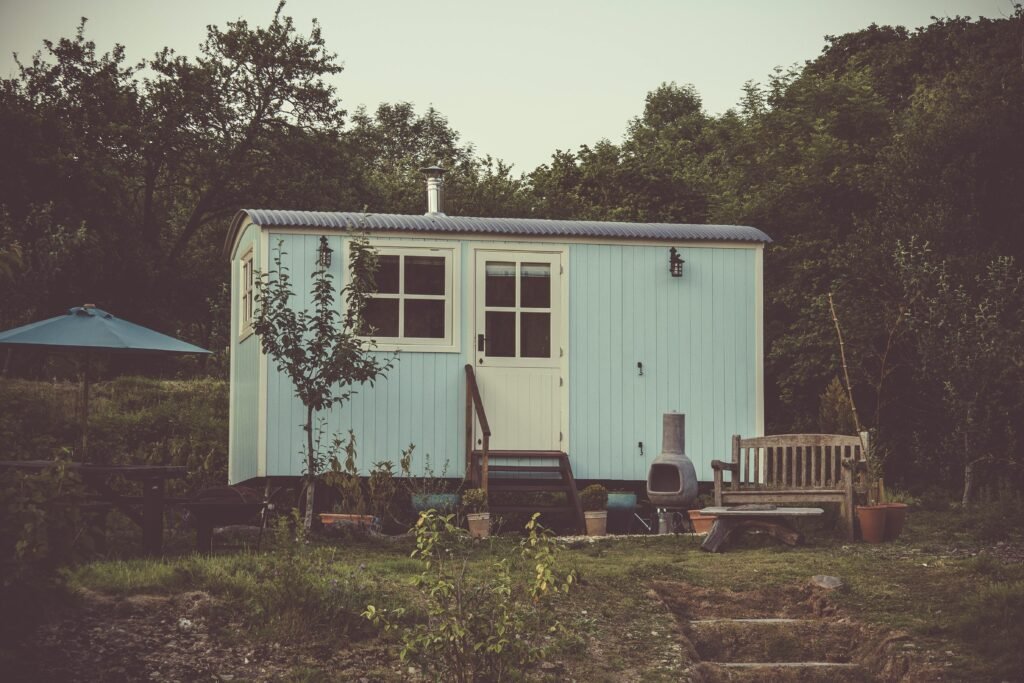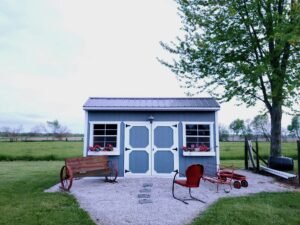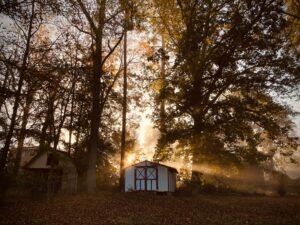Transforming Your Old Shed into a Inspiring Studio: A Creative Journey

Introduction
Have you ever gazed upon your old, weathered shed and felt a pang of inspiration? It's time to turn that neglected storage space into a vibrant studio where creativity knows no bounds. In this article, we embark on an exciting journey of repurposing old sheds, transforming them from forgotten corners of our yards into havens of artistic expression and productivity.
Embracing the Possibilities: From Storage to Studio
 Repurposing an old shed into a studio begins with a spark of imagination. Instead of seeing it as a mere storage unit, envision it as a blank canvas awaiting your creative touch. Whether you're a seasoned artist, a budding writer, a musician, or simply a lover of crafts, a studio provides the perfect sanctuary to nurture your talents and explore your passions.
Repurposing an old shed into a studio begins with a spark of imagination. Instead of seeing it as a mere storage unit, envision it as a blank canvas awaiting your creative touch. Whether you're a seasoned artist, a budding writer, a musician, or simply a lover of crafts, a studio provides the perfect sanctuary to nurture your talents and explore your passions.
Planning for Success: Assessing Your Space
Before diving into the transformation process, consider assessing your shed and envisioning its potential as a studio space. Consider factors such as the shed's size and layout and its existing features such as windows, doors, and flooring. Evaluate the natural light that enters the space throughout the day and the ventilation options available. By carefully analyzing these elements, you can develop a clear vision of optimizing your shed and creating a studio that inspires creativity and productivity.
Things to Consider When Transforming Your Shed into a Studio
- Size and Layout: Evaluate the dimensions and arrangement of your shed to decide on the most effective way to use the area. Consider whether structural modifications are needed to create an open, functional layout conducive to your creative pursuits.
- Lighting: Evaluate the natural light sources in the shed and consider additional lighting options to ensure adequate illumination for working comfortably. Blend different types of lighting, such as overhead, task-oriented, and natural light, to establish an adequately illuminated space.
- Ventilation: Sufficient airflow is crucial for ensuring a pleasant and healthful environment within a studio setting. Ensure proper airflow by installing windows that can be opened, adding vents, or incorporating fans to regulate temperature and air quality.
- Insulation: Depending on your climate, insulation may be necessary to regulate temperature and minimize external noise. Insulating the walls and ceiling of the shed will improve its comfort and make it suitable for use throughout the year.
- Storage Solutions: Plan for adequate storage solutions to keep your supplies organized and easily accessible. Incorporate shelves, cabinets, and storage bins to maximize space and minimize clutter, allowing you to focus on your creative work without distractions.
- Electricity and Power Outlets: Evaluate the electrical configuration in your shed to confirm it meets the requirements for your studio activities. Consider engaging a certified electrician to add power outlets, lighting fixtures, or other essential electrical upgrades.
- Flooring: Select flooring options that offer durability, low maintenance, and cater to your artistic endeavours. Options like laminate, vinyl, or sealed concrete are ideal for studio spaces, offering functionality and aesthetic appeal.
- Accessibility: Consider the accessibility of your studio space, especially if you plan to use it frequently or for extended periods. Ensure easy access to the shed from your home or workspace, and consider factors such as pathways, ramps, and entryways to accommodate any mobility needs.
Unleashing Your Creativity: Designing Your Dream Studio
 With a clear vision, it's time to unleash your creativity and design the studio of your dreams. Consider the desired look and feel – whether a snug hideaway filled with nostalgic discoveries or a polished, contemporary environment boasting simplicity and uncluttered design. Consider different ways to maximize functionality and mobility while allowing room for your style to shine through your design choices.
With a clear vision, it's time to unleash your creativity and design the studio of your dreams. Consider the desired look and feel – whether a snug hideaway filled with nostalgic discoveries or a polished, contemporary environment boasting simplicity and uncluttered design. Consider different ways to maximize functionality and mobility while allowing room for your style to shine through your design choices.
Practical Considerations: Making Your Studio Functional
While aesthetics are important, consider the practical aspects of creating a functional studio space. Consider allocating resources toward storage solutions that enhance the organization and accessibility of your supplies. This might involve investing in shelving units, cabinets, or storage bins to streamline your storage system. Consider incorporating workspace essentials like a sturdy desk or table, comfortable seating, and adequate lighting to support your creative endeavours. Additionally, ensure that your studio is equipped with proper ventilation to maintain a comfortable environment for extended work periods.
Creative Ideas
Revitalizing an aging shed can infuse fresh vitality into your backyard sanctuary. Let's delve into innovative concepts to metamorphose your storage shed into a practical and inspiring studio:
Craftsman's Workshop (Art Studio):
- Harness Natural Illumination: Infuse the studio with radiant sunlight through expansive windows or skylights.
- Versatile Palette: Opt for neutral hues on the walls to provide a flexible canvas for your artistic endeavors.
- Storage Galore: Organize art supplies, easels, and ongoing projects to optimize space and workflow.
- Personal Flourish: Adorn the space with captivating artwork and decor that mirrors your artistic essence.
Writer's Nook (Home Office):
- Soothing Ambiance: Embrace soft lighting, plush seating, and inviting fabrics to cultivate a serene ambiance.
- Tranquil Tones and Organic Materials: Foster tranquility with muted colors and natural elements.
- Writing Haven: Designate a cozy corner with a snug chair and ample writing surface.
- Literary Haven: Implement storage solutions for books and essentials, fostering an organized and productive retreat.
Zen Den (Yoga Sanctuary):
- Tranquil Oasis: Envelop the space in serene hues, tactile textures, and gentle lighting to induce serenity.
- Grounded Flooring: Opt for bamboo flooring or plush mats for a comfortable foundation during yoga practice.
- Natural Integration: Introduce elements of nature such as potted plants, fresh blooms, or a serene water feature.
- Yoga Essentials: Equip the sanctuary with mats, blocks, bolsters, and straps to facilitate mindful practice.
Work Oasis (Home Office):
- Work-Life Balance: Establish a dedicated home office area to delineate professional and personal spheres.
- Strategic Layout: Arrange furniture close to outlets for easy access to electronic devices and chargers.
- Illuminating Perspective: Position the office near a window to invite natural light and invigorate your workspace.
 Remember to acquaint yourself with local ordinances and secure requisite permits before embarking on your shed conversion journey. Whether fashioning an art haven, professional nook, or tranquil retreat, repurposing your shed can enrich your lifestyle and foster boundless creativity! 🏡🎨📝🧘♀️
Remember to acquaint yourself with local ordinances and secure requisite permits before embarking on your shed conversion journey. Whether fashioning an art haven, professional nook, or tranquil retreat, repurposing your shed can enrich your lifestyle and foster boundless creativity! 🏡🎨📝🧘♀️
Other Ways to Repurpose A Shed
Repurposing a shed offers endless possibilities beyond just creating a studio. Here are some alternative ways to repurpose a shed:
- Workshop or Hobby Space: Transform your shed into a dedicated workshop for woodworking, crafting, or DIY projects. Equip it with workbenches, tool storage, and ample workspace to indulge your passion for hands-on activities.
- Outdoor Entertainment Area: Convert your shed into an outdoor bar, lounge, or entertainment space for hosting gatherings and socializing with friends and family. Add seating, a bar counter, and ambient lighting to create a cozy and inviting atmosphere.
- Guest Cottage or Airbnb Rental: Renovate your shed into a charming guest cottage or rental for extra accommodation space or supplemental income. Install a bed, bathroom facilities, and basic amenities to offer a comfortable stay for guests.
- Gardening or Potting Shed: Repurpose your shed into a gardening oasis for storing tools, potting plants, and tending to your garden. Add shelves, hooks, and work surfaces to organize gardening supplies and create a functional workspace.
- Home Gym or Fitness Studio: Convert your shed into a private gym or fitness studio where you can work out and stay active. Install exercise equipment, mirrors, and flooring suitable for workouts, and create a motivating environment to inspire your fitness goals.
- Home Office or Remote Workspace: Create a tranquil home office or remote workspace in your shed, providing a dedicated environment for focused work and productivity. Furnish it with a desk, comfortable seating, and technology essentials to support your professional endeavors.
- Creative Retreat or Meditation Space: Design a serene retreat for relaxation, meditation, or creative pursuits in your shed. Decorate it with cozy seating, soft lighting, and calming decor to foster a sense of tranquillity and inspiration.
- Pet Retreat or Animal Shelter: Repurpose your shed into a cozy retreat for your furry friends or a shelter for needy animals. Create separate areas for sleeping, feeding, and play, and ensure the space is safe, comfortable, and well-ventilated.
- Home Storage or Utility Room: Utilize your shed as a practical storage space for household items, seasonal equipment, or outdoor gear. Install shelves, cabinets, and hooks to maximize storage capacity and keep belongings organized and accessible.
- Artisanal Studio or Craft Boutique: Establish a creative studio or boutique in your shed to showcase and sell handmade crafts, artwork, or artisanal products. Design it as a charming storefront or gallery space to attract customers and showcase your creative talents.
These are just a few examples of repurposing a shed to suit your needs and interests. With a touch of imagination and resourcefulness, the opportunities are boundless!
When to Consider Repurpose
Various factors and circumstances can prompt the idea of repurposing a shed. Here are some situations when it might be opportune to contemplate repurposing a shed:
- Unused or Neglected Space: If your shed serves little to no purpose and sits unused or neglected in your backyard, it may be an ideal candidate for repurposing. Repurposing can breathe new life into the space and maximize its potential utility.
- Changing Needs or Lifestyle: Changes in your lifestyle, hobbies, or household dynamics may necessitate reevaluating how your shed is utilized. If your needs have evolved and your shed no longer aligns with your current priorities, repurposing it to suit your lifestyle better can be wise.
- Desire for Additional Space: If you need additional space for a specific purpose, such as a home office, art studio, or storage area, repurposing your shed can provide a cost-effective and practical solution. It allows you to expand your living or working area without requiring extensive renovations or construction.
- Renovation or Upgrade Opportunity: If your shed needs renovation or repair due to age, wear and tear, or structural issues, repurposing it presents an opportunity to not only address these issues but also enhance its functionality and aesthetics. Transforming the shed into a new purpose-built space can justify the investment in renovation efforts.
- Interest in Sustainable Practices: Repurposing a shed aligns with sustainability principles by giving existing structures a new lease on life instead of constructing new ones from scratch. Repurposing can be a sustainable choice if you're committed to reducing waste, minimizing environmental impact, and maximizing resource efficiency.
- Financial Considerations: Repurposing a shed can be a cost-effective alternative to building an entirely new structure or purchasing pre-fabricated units. Utilizing existing space allows for cost savings by reducing expenses related to construction, permits, and other fees typically associated with new building projects.
- Creative Vision or Inspiration: Sometimes, the decision to repurpose a shed is driven by a creative vision or inspiration to transform the space into something unique and meaningful. Whether it's a studio, workshop, or relaxation retreat, repurposing allows you to unleash your creativity and personalize the space according to your vision.
Overall, the decision to consider repurposing a shed is influenced by a combination of practical needs, lifestyle preferences, environmental consciousness, and creative aspirations. By evaluating these factors and assessing the potential of your shed, you can determine whether repurposing is the right choice for you.
DIY vs. Professional
They are deciding between tackling a repurposing project independently or hiring a professional hinges on several factors: your proficiency, schedule flexibility, financial resources, and the project's complexity. DIY endeavors can offer personal satisfaction and savings but often demand considerable time, energy, and know-how. Conversely, engaging professionals guarantees superior artistry and becomes essential for intricate renovations or significant structural alterations.
Tips and Techniques
- Start with a clear plan: Outline your objectives, budget, and timeline before starting the project.
- Emphasize functionality as your primary goal: Craft a space that fulfills your practical requirements and improves your daily life.
- Use reclaimed materials: Integrate salvaged or recycled materials to infuse personality into the design and save on expenses.
- Think about versatility: Plan the renovated shed to fulfill various roles or quickly adapt to evolving needs as time goes on.
- Seek inspiration: Explore online resources, home improvement magazines, and DIY tutorials for ideas and inspiration.
How to Save in Repurposing
- Salvage and repurpose materials: Look for opportunities to reuse or repurpose existing materials from the shed or other sources.
- Shop smart: Compare prices, look for sales or discounts, and consider buying used or discounted materials to save on costs.
- DIY where possible: Undertake tasks that you feel comfortable and capable of completing yourself to save on labour costs.
- Optimize space: Maximize the use of available space and avoid unnecessary additions or expansions that can drive up costs.
- Plan: Careful planning and preparation can help minimize waste, prevent costly mistakes, and streamline repurposing.
FAQs
- Q: How much does it cost to repurpose a shed? A: The cost of repurposing a shed can vary depending on the extent of renovations, materials used, labor costs, and location. DIY projects may cost less than hiring professionals, but costs can range from a few hundred to several thousand dollars.
- Q: Can I repurpose a shed on my own? A: Many homeowners successfully repurpose sheds by undertaking DIY projects. However, complex renovations or structural modifications may require professional assistance.
- Q: What permits are needed to repurpose a shed? A: Permit requirements vary by location and the scope of the project. It's essential to contact your local building department to determine if permits are required for the specific changes you plan to make.
Key Takeaways
- Repurposing a shed can be cost-effective and sustainable to enhance your living or working space.
- Consider your needs, budget, and skill level when deciding whether to undertake the project or hire a professional.
- Save costs by salvaging materials, shopping smart, optimizing space, and planning carefully to ensure a successful repurposing project.
Table of Cost of Materials
| Material | Estimated Cost (USD) |
| Lumber | $200 - $500 |
| Insulation | $100 - $300 |
| Flooring | $200 - $800 |
| Windows/Doors | $100 - $500 (each) |
| Lighting Fixtures | $50 - $200 (each) |
| Paint/Stain | $50 - $200 |
| Electrical Wiring | $100 - $500 |
| Plumbing Fixtures | $100 - $500 |
| Miscellaneous Tools | $50 - $200 |
The provided cost estimates are rough approximations and may fluctuate based on factors such as the quality of materials, the quantity needed, and the specific location.
Final Touches: Bringing Your Studio to Life
As you put the finishing touches on your studio, take a moment to reflect on the journey you've undertaken. Personalize the space with decorative touches that inspire and motivate you, such as artwork, plants, or meaningful mementos. Imagining your creative space with unique elements that mirror your creative process can be enriching. Whether it's a dedicated inspiration board adorned with captivating images and quotes or a cozy reading nook nestled in a corner where you can unwind and replenish your creative energy between moments of inspiration, infusing your space with personalized touches enhances the overall ambiance and nurtures your creativity. With each thoughtful detail, your old shed will be transformed into a space that supports your creative endeavors and reflects your unique personality and artistic vision.
Conclusion: A Space for Creativity to Flourish
In conclusion, repurposing old sheds into studios is more than just a practical solution for creating a workspace –a journey of transformation and self-expression. By reimagining neglected spaces and infusing them with creativity and purpose, we breathe new life into our surroundings and unlock new possibilities for artistic exploration and growth. So let your imagination run wild, and let your old shed become the studio of your dreams – a space where creativity can truly flourish.
- Crafting Cost-Effective Solutions: Affordable Shed Construction Explained
- Empowering Your Space: Tips for Managing Shed Construction Budget
- Unveiling Shed Building Cost Estimator: Your Budgets Best Friend
- Revamp Your Shed: Creative Shed Base Ideas for Your Outdoor Oasis
- Elevate Your Shed Game: Unveiling the Magic of Concrete Foundations
- Budget-Friendly Solutions: Exploring Prefab Shed Prices
- Step-by-Step Gravel Shed Foundation Building Made Easy
- Solid Foundations: Choosing the Perfect Wooden Shed Foundation
- Empower Your Space: The Ultimate Guide on How to Build a Shed Foundation
- Build Smarter, Not Pricier: Cost-Effective Shed Building Essentials

Leave a Reply